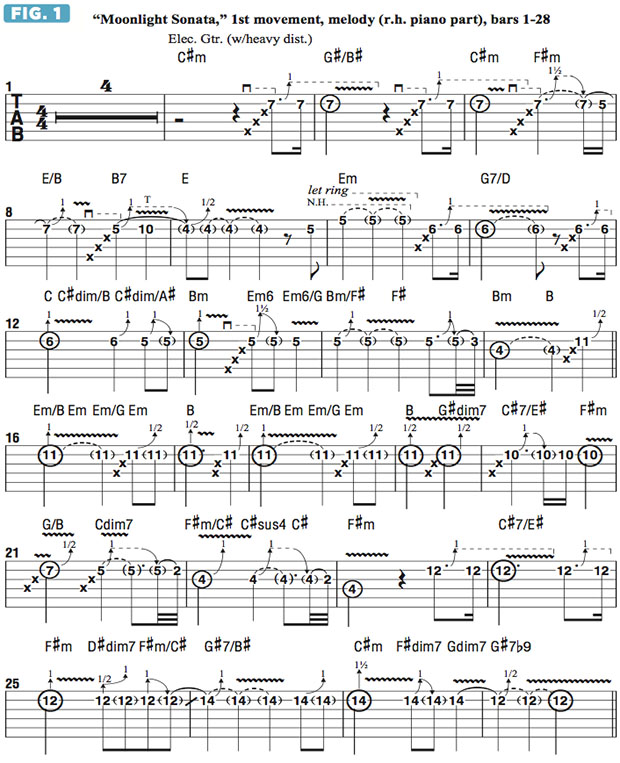A David Gilmour-Style Approach to Beethoven's “Moonlight Sonata”
The melody of Beethoven's “Moonlight Sonata”, re-imagined in the style of David Gilmour.

Continuing my two-guitar arrangement of the first movement of Ludwig van Beethoven’s “Moonlight Sonata,” I now present its sparse, haunting melody, which I play in a classic hard rock lead style inspired by David Gilmour’s lyrical wailing on such Pink Floyd songs as “Shine on You Crazy Diamond,” “Time” and “Comfortably Numb.”
I call this part “Shine on You Crazy Moon: A Study in Feeling and Control” because it features lots of emotive string bends and finger vibratos that require a seasoned musical ear and a refined touch to execute well and achieve the desired voice-like quality…it’s all about making your ax sing and cry.
For a guitar sound, dial in some heavy distortion to achieve a harmonics-rich, violin-like tone and give the bends plenty of sustain and “hang time.” Use your guitar’s bridge pickup, along with an equalizer to roll off the highest treble frequencies (above 4kHz) and filter out the harsh-sounding upper harmonics.
Also roll off the lows below 100Hz, to suppress unwanted rumble and “pick thud.” A “reverse EQ scoop,” if you will. Top it all off with some spacious hall reverb and delay trails to enhance the part’s epic quality. FIGURE 1 shows roughly the first half of my melody arrangement, up to the point where the lead guitar drops out for about a minute and the accompaniment (which I presented in the Holiday 2015 and January 2016 issues) takes over momentarily with a chain of cascading arpeggios.
The melody enters in bar 5 with what I call a “mute, rake, bend and shake,” which literally describes what’s going on. Lightly rest your fret-hand index finger across the middle strings as you drag the pick across them in a downstroke sweep to create a percussive, pitch-less grace-note rake into the first bend, which you’ll want to fret with your ring finger, supported by the middle finger one fret lower for added “push power.”
Focus on precisely nailing the bend’s target pitch, which is a whole step (from F# to G#), pick the string twice more, as indicated, then, on the downbeat of bar 6, apply a wide, even vibrato to the already-bent note. This is done by releasing the bend by about a quarter step, then restoring it to pitch several times in quick succession, but not too quickly, as that can sound nervous and amateurish.
You can use these same raking, fingering and vibrato techniques for most of the bends that follow. Be very mindful throughout of the indicated degree to which each note is to be bent. Some of the bends, like the first few, are a whole step (indicated by the number 1), which means you are to bend the note up to match the pitch of an unbent note two frets higher on the same string.
Other bends are only a half step, equal to moving up just one fret without bending, and there are three big, one-and-one-half-step bends (equal to an unbent note three frets higher), in bars 7, 13 and 27. You can check the pitch of each bend by comparing it to its unbent equivalent. For more detailed instruction on playing this arrangement, watch this column’s video lesson online. Next month, the conclusion of the melody.

Get The Pick Newsletter
All the latest guitar news, interviews, lessons, reviews, deals and more, direct to your inbox!
Over the past 30 years, Jimmy Brown has built a reputation as one of the world's finest music educators, through his work as a transcriber and Senior Music Editor for Guitar World magazine and Lessons Editor for its sister publication, Guitar Player. In addition to these roles, Jimmy is also a busy working musician, performing regularly in the greater New York City area. Jimmy earned a Bachelor of Music degree in Jazz Studies and Performance and Music Management from William Paterson University in 1989. He is also an experienced private guitar teacher and an accomplished writer.
“There are so many sounds to be discovered when you get away from using a pick”: Jared James Nichols shows you how to add “snap, crackle and pop” to your playing with banjo rolls and string snaps
Don't let chord inversions bamboozle you. It's simply the case of shuffling the notes around








![Joe Bonamassa [left] wears a deep blue suit and polka-dotted shirt and plays his green refin Strat; the late Irish blues legend Rory Gallagher [right] screams and inflicts some punishment on his heavily worn number one Stratocaster.](https://cdn.mos.cms.futurecdn.net/cw28h7UBcTVfTLs7p7eiLe.jpg)


